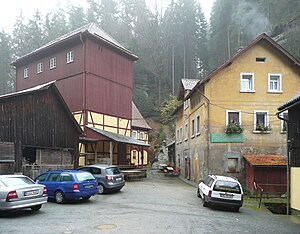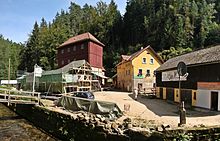Buschmühle (Sebnitz)
| Bushmill
|
||
|---|---|---|
|
The Buschmühle in Kirnitzschtal (photo 2008) |
||
| Location and history | ||
|
|
||
| Coordinates | 50 ° 55 '29 " N , 14 ° 17' 16" E | |
| Location | Sebnitz - Ottendorf ( Saxon Switzerland ) | |
| Waters | Kirnitzsch | |
| Status | Preserved water wheel and functioning as a generator drive | |
| technology | ||
| use | Formerly a grain mill / sawmill / forge , today a small hydropower , inn and guesthouse . | |
| drive | Watermill | |
| water wheel | Medium-sized; 5 m diameter; 1.6 m wide | |
| Website | www.die-buschmuehle.de | |
The Buschmühle is a mill located in the Kirnitzschtal , first mentioned in the 16th century in the Upper Saxon Switzerland . As the last mill in the Kirnitzschtal valley, it served as a grinding mill until 1992, and since then it has been a restaurant and hikers' hostel. The mill has been in the Saxon Switzerland National Park since 1990 and belongs to the Ottendorf district of the city of Sebnitz .
history
Like the neighboring Neumannmühle , a few hundred meters further downstream , the Buschmühle was first mentioned in a document in the 16th century. The first miller known by name was Jonas Keßler, who is mentioned for 1547 in the Hohnstein Office's register of inheritance . In 1576 two board mills are mentioned at the confluence of the Großer Zschand in the Kirnitzschtal , which were the two mills and both belonged to Ottendorf farmers. There is a purchase contract for the mill for 1648, but the buyer can no longer be determined. In 1698 Andreas Sturm and Christoph Friedrich owned the mill, which at that time was still called the "Ellmerische Brethmühle" after a previous owner, but was also known as the Buschmühle around 1700. At their joint application, in 1710 they received permission to convert the board mill into a grinding mill. In 1721, Sturm took over Friedrich's shares and sold the entire property to his son of the same name. He sold the mill to Johann Georg Schaffrath from Hertigswalde , who ran it until his death in 1745. In 1770 his son Carl Gottlieb Schaffrath applied for a petition to the Saxon Elector Friedrich August III. the re-establishment of a cutting passage so that the mill can also be used as a board mill. According to his complaint, the pure grinding mill produces little income due to its remote location. Despite support from the owners of the Ottendorf and Hertigswalde inheritance courts , the request was rejected with reference to the existing board mills in the Kirnitzschtal. In the same year the miller died and his wife married the miller Johann Gottfried Glaser for the second time.
In 1780 the mill, which at that time stood at the confluence of the Ottendorfer Dorfbach in the Kirnitzschtal, i.e. on the right bank of the Kirnitzsch, burned down. During the reconstruction from 1784 onwards, Glaser also had a cutting mill installed at today's location on the left Kirnitzschufer, a little below the previous location, but was not allowed to operate it. It was not until 1821 that the Saxon Ministry of Finance approved the operation of his son of the same name as a board mill after he referred to his many years of service in the Saxon army. Since then, the bush mill has been both a grinding mill and a board mill. In addition, the miller operated a small farm on a located above the valley Räumicht , the so-called Jentschdörfel . In 1791 he laid a path made of sandstone slabs to this room, which has since been called Buschmüller's or Glaser's room . In 1797 a forge was added to the mill .
At the turn of the 19th century, more and more visitors discovered the scenic charms of Upper Saxon Switzerland. They liked to use the often lonely mills as places to stop and overnight due to the lack of available inns. The Buschmühle was also popular, which is why the Buschmüller had already applied for and received a license to produce brandy at the end of the 18th century. Wilhelm Leberecht Götzinger , who gave the first comprehensive description of Saxon Switzerland in his books and also popularized the name of the landscape, praised the local knowledge and hospitality of the millers.
An attempt to use the Buschmühle in a similar way to the neighboring Neumannmühle for the production of wood pulp failed in 1869. For this purpose, the millers had expanded the restaurant considerably since the middle of the 19th century. In 1904 the Buschmüller had two arbors built for the summer months, and 10 guest rooms with a total of 17 beds were created in the side building. When there was a large crowd, additional straw stores were set up. During this time, the Buschmühle gained an almost legendary reputation, especially among climbers, and has since been a preferred stop for hikers and mountaineers. Even without a license, the Buschmüller occasionally organized dance events for the surrounding villages, which led to corresponding advertisements. Between the wars, the mill passed from the Glaser family to the Schiemann family through marriage.
After the Second World War, the busch miller Walter Schiemann modernized the mill by adding a grain silo and new roller mills. The drive source remained the medium-sized water wheel with a diameter of 5 m and a width of 1.6 m. Walter Schiemann and his son-in-law Edgar Gernert operated the Buschmühle as a grinding and cutting mill until after the fall of the Wall . The last scrap sack left the mill in 1992 . The entire system is still there, the mill wheel is used to generate electricity for the needs of the restaurant.
In 2008, Stefan Gernert became the operator of the Buschmühle. In the same year the Buschmühle served as a backdrop for the film "The Reader" .
Flood 2010
In August 2010 the Buschmühle was badly damaged in a flood of the Kirnitzsch. The buildings were partially washed away and badly damaged, the bridge over the Kirnitzsch, which served as an access road, was swept away by the floods. The buildings alone suffered damage of around 400,000 euros. Due to the destruction of the bridge and severe damage to the Kirnitzschtalstraße, the mill was also no longer accessible, the busch miller Stefan Gernert and other people had to be flown out by helicopter . Extensive work and charity campaigns were then initiated by mountaineering clubs, and the painter Irmgard Uhlig made one of her pictures available for auction. In total, the campaigns generated several thousand euros in donations. The Buschmühle has been accessible again since autumn 2010 and has since resumed its guest operations.
literature
- Manfred Schober : The mills of Saxon Switzerland. Right Elbe area , monographs on Saxon-Bohemian Switzerland, Volume 2, Berg- & Naturverlag Rölke, Dresden 2009, ISBN 978-3-934514-24-9
Web links
Individual evidence
- ↑ a b c d e Manfred Schober: The mills of Saxon Switzerland. Right-Elbe area , monographs on Saxon-Bohemian Switzerland, Volume 2, Berg- & Naturverlag Rölke, Dresden 2009, ISBN 978-3-934514-24-9 , pp. 75–79
- ↑ a b Peter Rölke (Ed.): Wander- & Naturführer Sächsische Schweiz, Volume 1, Verlag Rölke, Dresden 1999, ISBN 3-934514-08-1 , p. 131 ff.
- ↑ a b History of the Buschmühle at www.die-buschmuehle.de (accessed on February 26, 2012)
- ↑ Manfred Schober: The mills of Saxon Switzerland. Left Elbe area, monographs on Saxon-Bohemian Switzerland , Volume 3, Berg- & Naturverlag Rölke, Dresden 2011, ISBN 978-3-934514-26-3 , p. 14
- ↑ Archive link ( Memento of the original from April 2, 2012 in the Internet Archive ) Info: The archive link was inserted automatically and has not yet been checked. Please check the original and archive link according to the instructions and then remove this notice. (accessed on February 26, 2012)
- ↑ die-buschmuehle.de, History of the Buschmühle , accessed on August 16, 2017
- ↑ Help for the bush mill (accessed on February 26, 2012)
- ↑ Mountaineers want to help the Buschmühle , Sächsische Zeitung, local edition Pirna, from August 11, 2010
- ↑ Climbers save cult bar in Kirnitzschtal , Dresdner Morgenpost from August 11, 2010


